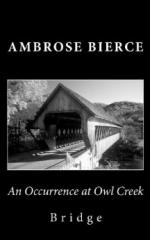|
This section contains 7,683 words (approx. 26 pages at 300 words per page) |

|
SOURCE: Ames, Clifford R. “Do I Wake or Sleep?: Technique as Content in Ambrose Bierce's Short Story, ‘An Occurrence at Owl Creek Bridge’.” American Literary Realism, 1870-1910 19, no. 3 (spring 1987): 52-67.
In the following essay, Ames argues that the popularity of “An Occurrence at Owl Creek Bridge” is a testimony to Bierce's technical skill, particularly his ability to manipulate perception and suspend disbelief.
What evidence could be applied to, supposing we were asked at this very moment whether we are asleep or awake—dreaming all that passes through our minds or talking to one another in the waking state.1
Peyton Farquhar, the unfortunate hero of Ambrose Bierce's short story “An Occurrence at Owl Creek Bridge,” learns to make the distinction between waking and dreaming the hard way, and the reader is left stranded at the end of the story with the uncomfortable feeling that the certain evidence Socrates sought...
|
This section contains 7,683 words (approx. 26 pages at 300 words per page) |

|


